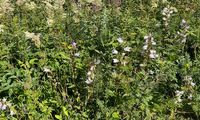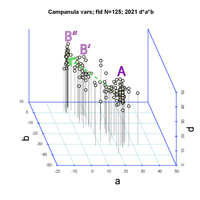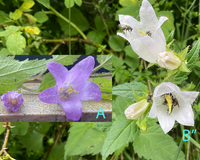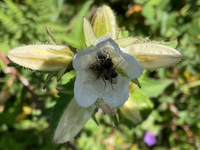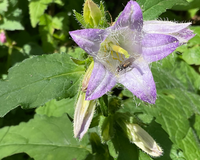S05 - Campanula (trachelium new subspecies "alba"?)
Verfolgen Sie hier Schritt für Schritt, wie man das Etablieren einer im Entstehen begriffenen Pflanzenvarietät analytisch begleitet. ... Das sehr dynamische System ist mir erstmals so richtig vor zwei Jahren aufgefallen. Das Phänomen scheint sich sehr schnell zu verbreiten.
Follow here step by step how to analytically accompany the establishment of a nascent plant variety. ... The very dynamic system first really came to my attention two years ago. The phenomenon seems to spread very quickly. (07-23-19)
Campanula trachelium Ssp. "alba"
Diese Varietät kommt wahrscheinlich nur im Unterengadin (Schweiz) häufiger vor. Dort scheint sich nach und nach aus der blauviolett blühenden Form zu evolvieren.
This variety is probably more common only in the Lower Engadine (Switzerland). There it seems to evolve gradually from the blue-violet flowering form.
Lokal auffallend sind die sehr hellen Formen, die Gruppenweise auch an halbtags besonnten Stellen vorkommen.
Locally conspicuous are the very bright forms, which occur in groups also on half-day sunny places.
Unterengadin Schweiz: Hellblaue Kreise, Nachweis der Nesselblättrigen Glockenblume in Transition
Vorkommen an schattigen feuchten Stellen in lichten Wäldern. Im Kontrast zu den sehr helllila bis weissen Formen die auch etwas mehr Sonne vertragen und entlang von Gebüschfluren in Ardez, Scuol und Sur-En anzutreffen sind. Es sind weniger als 100 Pflanzen bis heute gesichtet worden, die lokal in 95% rein-weisse Populationen gedeihen.
Lower Engadine Switzerland: Light blue circles, evidence of the Nettle-leaved Bellflower in transition. Over 20 populations in transition were discovered so far.
Occurs in shady moist places in sparse woods. Contrasting with the very light purple to white forms that can tolerate a little more sun and are found along stony scrubland in Ardez, Scuol and Sur-En. Less than 100 white variants have been sighted to date, thriving locally in currently in over 20 mixed populations.
a and b from Lab colorspace, d = length of flowers N=125.
Arrowhead indicates new median of white flowers.
A = Campanula trachelium; B' & B" C. trachelium Ssp. "alba".
Die neue Form ("alba") ist etwas grösser, pergamentweiss und zuweilen breit glockenförmig B". Die Fliegen ernähren sich vom Pollen und dienen der Pflanze als Bestäuber. Man beachte die Borstenhaare im oberen Teil der weissen Blüte. Die Blätter sind bei beiden Formen morphologisch gleich.
The new form ("alba") is slightly larger, parchment-white and sometimes broadly bell-shaped "B". The flies feed on pollen and serve as pollinators for the plant. Note the bristle hairs in the upper part of the white flower. The leaves are morphologically the same in both forms A & B.
Flies love to hold a group meeting in this bloom when it is in the male phase. There is pollen to eat and also thes pollinate the flowers in this way.
Occurrence of the white form sympatric with the blue variety in the canton of Glarus at 1600 meters altitude on rocky clearing. One population only!
Two plants in the change of its blooming program: One can clearly see on the buds, how the blue coloration is produced with a delay. The open flower is then also not saturated in its coloring. - The next step will then probably be that the blue coloring remains completely down regulated. The flower will remain white colored during full anthesis after the change.
Situation rund um Ramosch Unterengadin Herbst 2021: Innerhalb der hellgrün gestrichelt umrandeten Fläche sind sowohl reine blauviolett Blütenformen zu finden aber auch weisse oder hell blühende Formen von C. trachelium. Ausserhalb dieses Bereiches existieren jedoch nur blauviolett-blühende Formen. Wird sich da etwas im Folgejahr andern? Jede Aenderung bringt einen Rückschluss auf eine zugrunde liegende Dynamik.
Situation around Ramosch Lower Engadine autumn 2021: Within the light green dashed area there are pure blue-violet flowering forms but also white or light flowering forms of C. trachelium. Outside this area there are only blue-violet flowering forms. Will something change in the following year? Every change brings a conclusion to an underlying dynamic.
Questions:
- Is this subspecies new or old?
- Will the range increase?
- Will the variability of the flowers within the populations decrease in the next years?
- Where else outside the Lower Engadine has this white subspecies been seen?
The answer to all these questions will be given in the next two years.
09-19-21 rolfy

